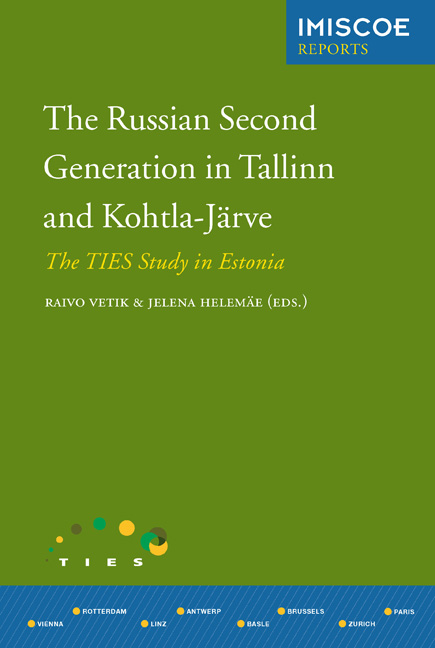Book contents
- Fronmatter
- Contents
- Preface
- List of Tables, Figures and Chapter Appendices
- 1 Introduction
- 2 Migration Patterns
- 3 Integration Policies
- 4 Ethnic Inequalities in Education
- 5 Explaining Different Returns from Human Capital in the labour Market
- 6 Income Inequality
- 7 Housing Conditions Andneighbourhood Satisfaction
- 8 Contact and Crisis in Interethnic Relations
- 9 Gender role Attitudes
- 10 Sense of Belonging to Estonia
- 11 Conclusions
- Appendix
- List of Contributors
- Other IMISCOE Titles
11 - Conclusions
Published online by Cambridge University Press: 20 January 2021
- Fronmatter
- Contents
- Preface
- List of Tables, Figures and Chapter Appendices
- 1 Introduction
- 2 Migration Patterns
- 3 Integration Policies
- 4 Ethnic Inequalities in Education
- 5 Explaining Different Returns from Human Capital in the labour Market
- 6 Income Inequality
- 7 Housing Conditions Andneighbourhood Satisfaction
- 8 Contact and Crisis in Interethnic Relations
- 9 Gender role Attitudes
- 10 Sense of Belonging to Estonia
- 11 Conclusions
- Appendix
- List of Contributors
- Other IMISCOE Titles
Summary
The analysis in this volume indicates that the main issues compounding the Russian second generation's integration are as follows: their segregation from the Estonian language society, which has its historical background in the policies and social processes of the former Soviet Union; disparity compared to their native peers, both in terms of social and economic opportunities, which is mostly the result of the new institutions established by the Estonian state after regaining independence; and reactivity of young Russians towards these policies, which has a potential to escalate, in certain conditions, into a large-scale conflict.
Soviet policy in Estonia could be characterised as a socialist type of modernisation of Estonian society. The ethnic segmentation, which emerged in that context, was in many ways the by-product of the bureaucratic command economy. Ethnic segmentation has emerged not only in the economic sphere, but also in education (two parallel school systems), the regional sphere (Ida-Virumaa and Tallinn versus the rest of Estonia), the neighbourhood (apartment houses were built either by pan-Soviet enterprises or by local authorities) and social networks (which were enterprise-centred). Besides ethnic segmentation, the Soviet period is also characterised by the Russians’ privileged status in many spheres of social and political life and the Estonians’ high level of threat perception regarding the rapidly growing share of migrant population and Russification policies, accompanying the demographic changes. These are important factors also in the context of the current integration issue in Estonia, mainly as the reasons behind the Estonians’ comparatively high ethnocentric attitudes, which in many ways can be regarded as a reaction to the fear and injustice experienced during the Soviet period.
After the restoration of independence, the Estonian political elite chose a nation-state model based on the legal continuity principle, in order to overcome the Soviet legacy and build up a new type of society and state, as well as in the context of internal power struggle. This principle, as such, is merely a legal notion, but the social and political consequences of its implementation carry very strong ethnic connotations. Since this legal model became the basis of many new social and political institutions, that strongly influence the cohesion of the society, it gave rise to an emergence of ethnic based status hierarchies (for example, by large-scale lack of Estonian citizenship among Russians).
- Type
- Chapter
- Information
- The Russian Second Generation in Tallinn and Kohtla-JärveThe TIES Study in Estonia, pp. 229 - 238Publisher: Amsterdam University PressPrint publication year: 2012



